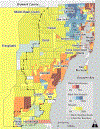A Multiscale Spatiotemporal Epidemiological Analysis of Neighborhood Correlates of Triple-Negative Breast Cancer
- PMID: 37971370
- PMCID: PMC11367848
- DOI: 10.1158/1055-9965.EPI-22-1255
A Multiscale Spatiotemporal Epidemiological Analysis of Neighborhood Correlates of Triple-Negative Breast Cancer
Abstract
Background: Women living in disadvantaged neighborhoods present with increased prevalence rates of triple-negative breast cancer (TNBC). This study takes a spatiotemporal epidemiological approach to understand the impact of socioenvironmental contextual factors on TNBC prevalence rates.
Methods: We analyzed 935 TNBC cases from a major cancer center registry, between 2005 and 2017, to explore spatial and space-time clusters of TNBC prevalence rates at the census tract and neighborhood scales. Spatial regression analysis was performed to examine relationships between nine socioenvironmental factors and TNBC prevalence rates at both ecological scales.
Results: We observed spatial clustering of high TNBC prevalence rates along a north-south corridor of Miami-Dade County along Interstate 95, a region containing several majority non-Hispanic Black neighborhoods. Among the ecologic measures, the percent of a region designated as a brownfield was associated with TNBC prevalence rates at the tract-level (β = 4.27; SE = 1.08; P < 0.001) and neighborhood-level (β = 8.61; SE = 2.20; P < 0.001).
Conclusions: Our spatiotemporal analysis identified robust patterns of hot spots of TNBC prevalence rates in a corridor of several disadvantaged neighborhoods in the northern half of the county. These patterns of TNBC align with the literature regarding at-risk groups and neighborhood-level effects on TNBC; however, remain to be validated in a population-based sample.
Impact: Spatial epidemiological approaches can help public health officials and cancer care providers improve place-specific screening, patient care, and understanding of socioenvironmental factors that may shape breast cancer subtype through gene-environment and epigenetic interactions.
©2023 American Association for Cancer Research.
Conflict of interest statement
Figures



Similar articles
-
Associations Between Neighborhood-Level Income and Triple-Negative Breast Cancer in a Majority-Minority Population.Ann Surg Oncol. 2024 Feb;31(2):988-996. doi: 10.1245/s10434-023-14517-w. Epub 2023 Nov 17. Ann Surg Oncol. 2024. PMID: 37978105
-
Triple-negative breast cancer incidence in the United States: ecological correlations with area-level sociodemographics, healthcare, and health behaviors.Breast Cancer. 2021 Jan;28(1):82-91. doi: 10.1007/s12282-020-01132-w. Epub 2020 Jul 15. Breast Cancer. 2021. PMID: 32671723 Free PMC article.
-
Neighborhood Social Environmental Factors and Breast Cancer Subtypes among Black Women.Cancer Epidemiol Biomarkers Prev. 2021 Feb;30(2):344-350. doi: 10.1158/1055-9965.EPI-20-1055. Epub 2020 Nov 24. Cancer Epidemiol Biomarkers Prev. 2021. PMID: 33234556 Free PMC article.
-
Racial Disparities in Triple Negative Breast Cancer: A Review of the Role of Biologic and Non-biologic Factors.Front Public Health. 2020 Dec 22;8:576964. doi: 10.3389/fpubh.2020.576964. eCollection 2020. Front Public Health. 2020. PMID: 33415093 Free PMC article. Review.
-
Biologic, demographic, and social factors affecting triple negative breast cancer outcomes.Clin J Oncol Nurs. 2015 Feb;19(1):62-7. doi: 10.1188/15.CJON.62-67. Clin J Oncol Nurs. 2015. PMID: 25689650 Review.
Cited by
-
Breast cancer screening needs assessment in 19 Northern California counties: geography, poverty, and racial/ethnic identity composition.Cancer Causes Control. 2025 Apr;36(4):369-377. doi: 10.1007/s10552-024-01943-8. Epub 2024 Dec 1. Cancer Causes Control. 2025. PMID: 39616300 Free PMC article.
-
Social Genomic Determinants of Health: Understanding the Molecular Pathways by Which Neighborhood Disadvantage Affects Cancer Outcomes.J Clin Oncol. 2024 Oct 20;42(30):3618-3627. doi: 10.1200/JCO.23.02780. Epub 2024 Aug 23. J Clin Oncol. 2024. PMID: 39178356 Review.
References
Publication types
MeSH terms
Grants and funding
LinkOut - more resources
Full Text Sources

